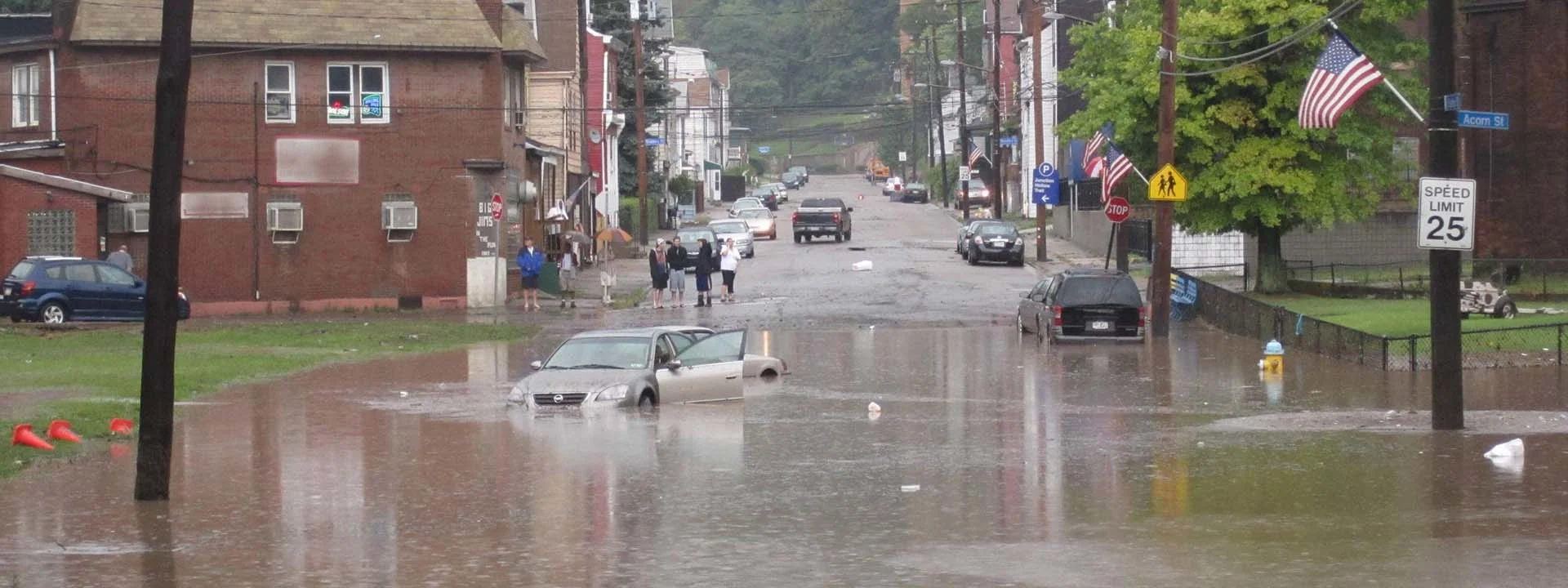
Research or Regress
What if we could prevent disasters before they strike?
Unseen damage beneath Pittsburgh's streets threatens lives and budgets. Penn State is pioneering technology for real-time prevention.
An early morning bus ride to work turned into a nightmare for Michelle Goodlow. As her Port Authority city bus paused at a red light, a massive sinkhole, over 20 feet deep, suddenly opened up at the intersection of 10th Street and Penn Avenue in downtown Pittsburgh, swallowing half of the bus. Thankfully, Goodlow and the driver survived the disaster with minor injuries, but the incident was a stark reminder of Pittsburgh’s crumbling, century-old infrastructure.
Penn State researchers have developed cutting-edge technology using existing underground fiber optic cables to give city officials an early warning system for failing pipes, sinkholes, and landslides.

This technology can be another tool in our toolbox to help make Pittsburgh more resilient and help ensure quality of life and public health.”
Beth Dutton
The Challenge: Protecting a City’s Aging Infrastructure
Beneath Pittsburgh’s streets lies a vast, yet fragile, network of water and sewer pipes. Most of this critical infrastructure was built between the 1930s and 1950s, meaning many pipes are now 80 to 100 years old and rapidly deteriorating.
These aging systems are a constant problem for the city and its residents. Leaking water mains can waste nearly half of Pittsburgh’s drinking water, leading to higher bills for residents and unnecessary strain on the sewer system. Broken sewer pipes contribute to sewage overflows into nearby rivers and streams, threatening water quality.
"Our current monitoring is reactive and fragmented," explains David Himes, a landscape architect who works for Penn State Outreach to engage the City of Pittsburgh and local communities to address place-based problems. Repair crews typically only respond after a major failure has become an emergency, like a bus falling into a sinkhole. Himes describes current monitoring as "playing whack-a-mole" when trying to pinpoint exact leaks or unstable slopes.
Every heavy rain risks new damage, disruptions, and expensive repairs. With recent record-breaking rainfall, landslides and flooding are also ever-present threats, destabilizing hillsides and endangering homes with little warning.
The Smart Solution: Listening with Fiber Optics
For Tieyuan Zhu, a Penn State associate professor of geosciences and geophysics, the answer to Pittsburgh's underground problems was already there—woven beneath the city’s streets. His innovative idea was to repurpose the city’s unused "dark fiber" optic cables. These are unused fiber networks already installed for telecommunications backup.
Zhu realized these unused cables could become a continuous, city-wide seismic sensor network. By sending laser pulses through them, his system can "listen" for tiny vibrations and shifts underground—the subtle early warning signs of water leaks, burst pipes, forming sinkholes, or shifting ground that triggers a landslide.
“The cables are already installed under streets and buildings,” Zhu explains. “It’s nearly zero cost compared to installing thousands of traditional sensors.”
Additionally, Zhu’s method doesn’t interfere with fiber optic communications. It can run continuously for years, capturing long-term data impossible with conventional monitoring.
From Reactive to Proactive: Helping Pittsburgh Protect and Save
The Penn State team isn’t just collecting data; they’re turning it into actionable information for Pittsburgh’s local utilities. They've developed smart machine learning programs that analyze patterns in the subtle underground vibrations, identifying early warnings of growing leaks or unstable ground.
“Since it can be hard to predict these events, public safety officials may not able to take precautionary measures to safeguard the public or protect properties,” said Beth Dutton, recent senior project manager for stormwater at Pittsburgh Water. “This technology can be another tool in our toolbox to help make Pittsburgh more resilient and help ensure quality of life and public health.”
It’s also user-friendly, a feature that Himes is excited about.
“Eventually, city crews will get notifications like: ‘At marker 1.3, we see a leak—please investigate,” Himes said. "This lets them schedule preventative repairs before crises occur, saving millions of dollars and protecting our residents.”
The impact is profound:
Preventing financial drain: Undetected water leaks become more expensive to repair over time, a cost ultimately borne by residents. This technology allows for preventative repairs, saving millions.
Enhancing public safety: Zhu emphasizes the life-saving potential, stating the technology can provide a ten second warning before a landslide. For sinkholes, the system can detect where and how deep the problem is developing, providing critical information for long-term planning and risk management.
This new fiber-optic sensing network gives Pittsburgh a real-time, comprehensive view of its underground conditions, allowing the city to move from simply reacting to disasters to actively preventing them.
A Blueprint for Resilient ‘Smart’ Cities
“By turning existing fiber optic cables into seismic sensors, we can give cities a real-time view underground—catching problems before they become disasters,” said Zhu.
Penn State's work in Pittsburgh is part of a larger vision to build "smart cities" that better protect vital infrastructure and residents. Aging infrastructure and intense rainfall are not unique to Pittsburgh; cities like New York and Philadelphia face similar issues and could greatly benefit from this scalable technology.
"By harnessing existing fiber optic networks, we’re giving city officials a powerful tool to maintain and upgrade critical infrastructure, all while saving costs and improving safety," Zhu concludes. "It’s a practical, effective solution for aging cities everywhere”
This is Penn State Research

What happens if it stops?
Learn more about the implications of federal funding cuts to your future.
